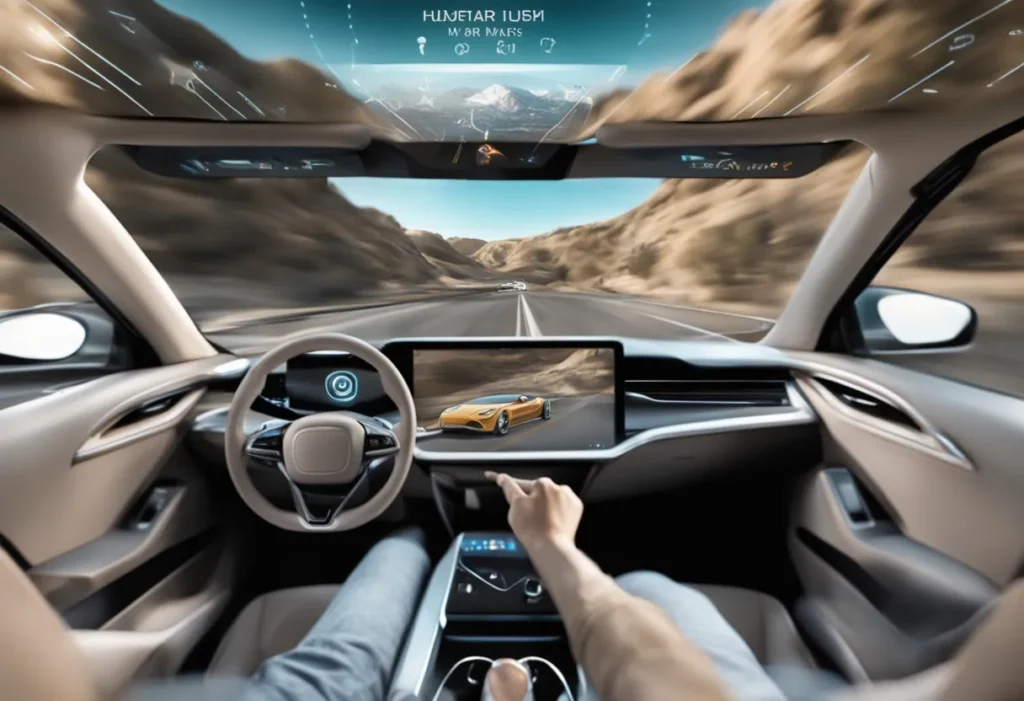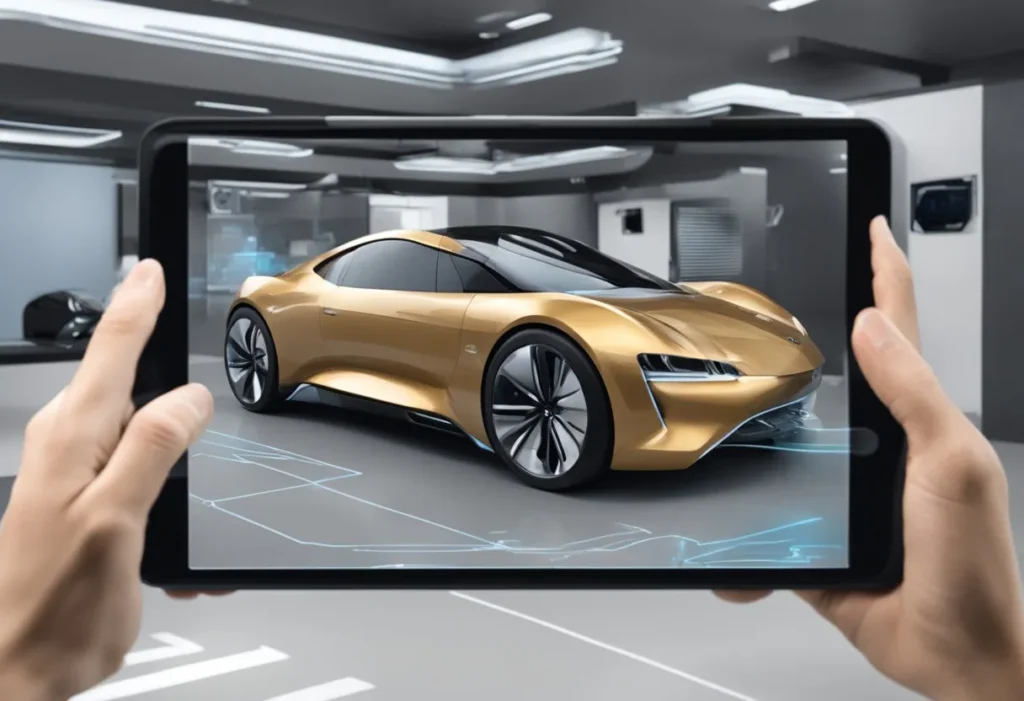Let me guess…
You’ve seen futuristic concept cars with glowing windscreens, AR overlays, and AI copilots.
Looks cool. But you’re thinking:
“That stuff’s probably for concept shows or Elon’s next tweet.”
Wrong.
AR in automotive is already being used by brands you know—in factories, showrooms, and even your own driveway.
Let me show you exactly how it works.

💡 What is AR in Automotive?
You know when you use Snapchat or Instagram filters that put stuff over your face?
That’s AR.
Now imagine that, but on your windscreen, dashboard, or mobile screen… showing real, useful car data.
You’re not leaving the real world—you’re adding smart layers to it.
🔍 Example:
Let’s say you’re test driving a car.
Instead of a boring screen on the dash, a live arrow floats on the road ahead, showing where to turn.
It even shows hazards, speed limits, or a lane change before you need it.
That’s not “future tech.”
That’s what Mercedes-Benz MBUX AR Navigation already does today.
👀 Why Should You Even Care?
Here’s where it gets real:
- You’re a driver → AR keeps your eyes on the road = safer + less distracted.
- You sell cars → AR helps customers visualise features without stepping into the car.
- You’re in auto repair → AR walks you through diagnostics step-by-step.
- You build cars → AR speeds up prototyping and cuts out errors on the floor.
It’s not optional anymore.
AR is a cheat code.
The only question is whether you’re using it or ignoring it.
🔧 How AR is Changing the Car Game Right Now

1. 🚘 Heads-Up Displays (HUDs)
What it does:
Projects info—speed, turn directions, warnings—onto the windscreen.
Why it matters:
- No more glancing at your dash.
- No more missed turns.
- Feels like Iron Man tech.
Example:
Mazda 3 and BMW Series 5 both offer AR HUDs with live road data.
Even Hyundai Kona has a scaled-down version.
2. 🗺️ AR Navigation
What it does:
Maps and arrows show on top of the real road, not just on a screen.
Why it matters:
- You turn where the arrow points in real-time, not by guessing from a flat map.
- Works in unfamiliar cities, bad weather, or night driving.
Example:
MBUX by Mercedes combines front camera + AR overlay.
It even shows building names and house numbers.
3. 🔧 AR for Car Maintenance
What it does:
Shows step-by-step repair instructions on the real engine.
Why it matters:
- Fewer errors
- Faster fixes
- Techs don’t need to memorise manuals
Example:
Porsche’s “Tech Live Look” uses AR glasses so remote experts can literally guide you by drawing on your screen in real time.
4. 🚙 Virtual Car Demos

What it does:
Customers use their phone to project a life-sized car in their driveway or living room.
Why it matters:
- Test the car without going to the showroom.
- Rotate, open doors, view features.
- Perfect for EV brands & online sales.
Example:
MG Motors India launched an AR showroom where users check out interiors, trims, even engine specs—straight from their phones.
Try it here: MG AR Experience
🎯 AR vs VR in Cars – What’s Actually Useful?
Quick fire comparison:
| Use Case | AR | VR |
|---|---|---|
| In-car Navigation | ✅ | ❌ |
| Repair Guidance | ✅ | ❌ |
| Customer Showrooms | ✅ | ✅ |
| Full Immersion (Training/Design) | ❌ | ✅ |
| Real-Time Driving Help | ✅ | ❌ |
🔑 Summary:
- AR = Add-on to reality
- VR = Fully immersive, often stationary
🚗 More Real Examples of AR in Automotive
| Brand | AR Use Case |
|---|---|
| Jaguar Land Rover | AR windscreen with 3D hazard detection & safety prompts |
| Hyundai | AR manual shows engine components on your phone |
| Porsche | AR glasses for remote diagnostics |
| Volkswagen | AR glasses for assembly line instructions |
| Audi | AR HUD with lane-level navigation |
| Toyota | AR apps for customer education & feature walk-through |
🧠 Mind-blowing fact:
Volkswagen cut manual training time by 30% using AR assembly overlays in their factories.
🛠️ Top Free Tools to Play with AR Tech
Wanna get your hands dirty?
These tools help you build or demo AR—even if you’re not a coder:
| Tool | What It Does | Link |
|---|---|---|
| 8thWall | Browser-based AR experiences | Visit |
| Zappar | Drag & drop AR builder | Visit |
| Unity + Vuforia | Full AR dev kit for pros | Visit |
| BlippAR | Interactive AR for sales/demo | Visit |
| Sketchfab | AR-compatible 3D model viewer | Visit |
🏭 AR in Design, Manufacturing & Sales – A Breakdown
⚙️ Design
- Designers use AR to preview models in real size.
- No clay, no mockups.
- Modify in real-time with teams across the world.
Example:
Ford’s Gravity Sketch lets design teams sketch cars in 3D space using AR tools.
Cuts weeks from early-stage development.
🏭 Manufacturing
- Factory workers see step-by-step assembly overlays.
- Real-time alerts if something’s off.
- Fewer errors = less waste.
Example:
Volvo cut downtime in their Belgium plant by using AR to highlight potential production faults before they happen.
💰 Sales & Marketing
- AR lets customers test cars virtually before visiting.
- Adds emotion. Adds clarity.
- Less guesswork, more engagement.
Example:
Tesla uses AR to preview their car interiors via mobile app.
⚖️ Pros and Cons – Let’s Keep It Real
✅ Pros:
- Safer, smarter driving
- Shorter training for service techs
- Slick customer experience
- Fast prototype + design feedback
- Hands-free navigation
❌ Cons:
- High setup cost for OEMs
- Not fully supported in older models
- Can overload driver if not designed right
- Needs strong internet / mobile devices
🔮 Future of AR in the Auto Industry
This is where it gets wild:
- Windshields as full dashboards
- Car-to-car AR alerts (think Waze + visuals)
- AR glasses as driver assist tools
- AI-powered AR for predicting traffic or hazards
This tech is already in R&D labs at Tesla, Apple Car Project, and Toyota.
We’re not decades away. We’re 2-5 years out.
❓ FAQs
Q: Can AR be added to older cars?
Yes – through third-party apps, head-up displays, or phones.
For example, Hudway turns your phone into an AR HUD.
Q: How do I experience AR without a new car?
Use mobile apps from MG, Hyundai, or even Google Maps’ AR mode.
Q: What’s the difference between AR HUD and normal HUD?
AR HUD interacts with the environment.
Normal HUD just shows static data like speed or RPM.
Q: How much does AR tech in cars actually cost?
It varies.
1Built-in AR HUDs can cost £1,000–£3,000 extra depending on the car model.
Aftermarket options (like Hudway or Navdy) start around £200.
But here’s the kicker:
For manufacturers, the real cost is in development, sensors, and software integration—not just the display.
Q: Is AR just a gimmick for marketing cars?
Not anymore.
It started that way, sure. But now it helps with:
Safer navigation
Live repair guidance
Driver training
Real-time hazard detection
If it saves lives or time—it’s not a gimmick.
Q: Does AR work in bad weather or at night?
Yes—if the system is built well.
Premium AR systems like those in Mercedes MBUX or Audi A8 use infrared + smart light sensors to adjust for rain, fog, or night conditions.
Cheaper models? Not so much.
Q: Do I need a special licence or training to use AR tech in cars?
Nope.
If you can drive, you can use AR HUDs or apps.
But if you’re working in repair or manufacturing, you might need platform-specific training.
Example: Porsche techs go through a crash course in using AR glasses for remote diagnostics.
Q: Which car brands are leading in AR right now?
Here’s the power list:
Mercedes-Benz – MBUX AR Nav is top-tier.
Porsche – Live AR support for service techs.
Jaguar Land Rover – Working on AR-assisted driving systems.
Hyundai/Kia – AR manuals + low-cost HUDs.
MG Motors – Pioneering virtual showrooms in India.
Tesla? Not yet AR-focused. They’re still leaning hard into AI and screen-based UX.
Q: Can I use AR while driving safely?
That’s exactly the point of AR—it makes driving safer, not riskier.
As long as:
The UI is clean
You’re not overloaded with visuals
It’s integrated with sensors and real-time data
You’re good.
Q: Which smartphones or devices support automotive AR apps?
Most modern smartphones do:
iPhones (XR and up)
Android (ARCore supported models)
Just check the app store descriptions. If you’ve bought a phone in the last 3–4 years, you’re probably covered.
🔗 Know More
👉 AR in Medical Education
👉 AR in Business & Marketing
👉 AR in Gaming & Entertainment

